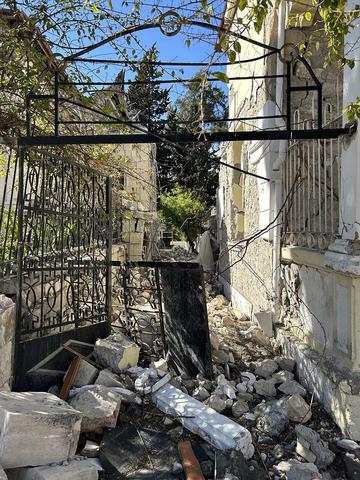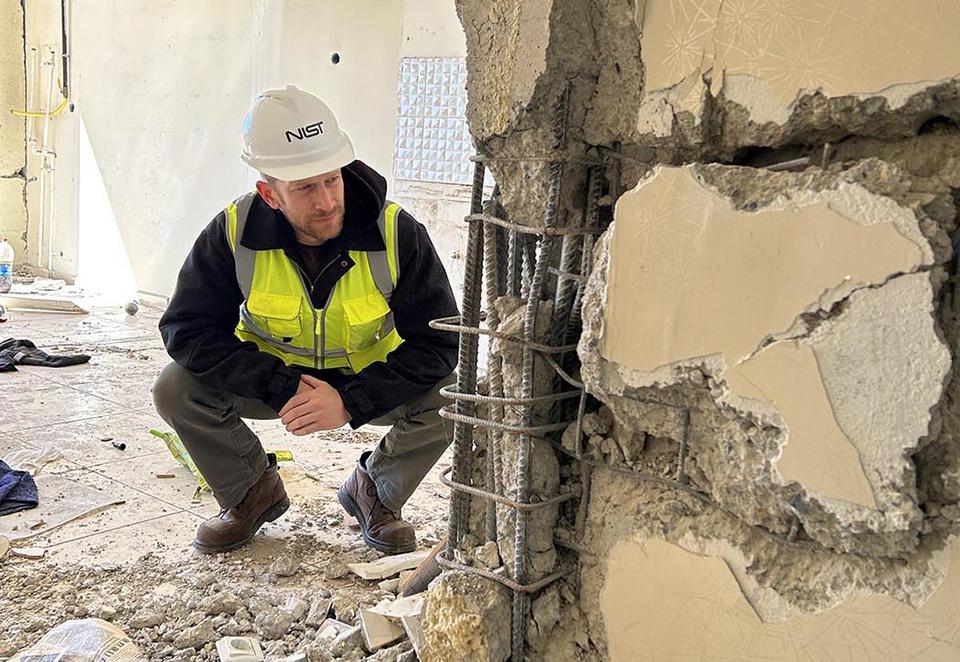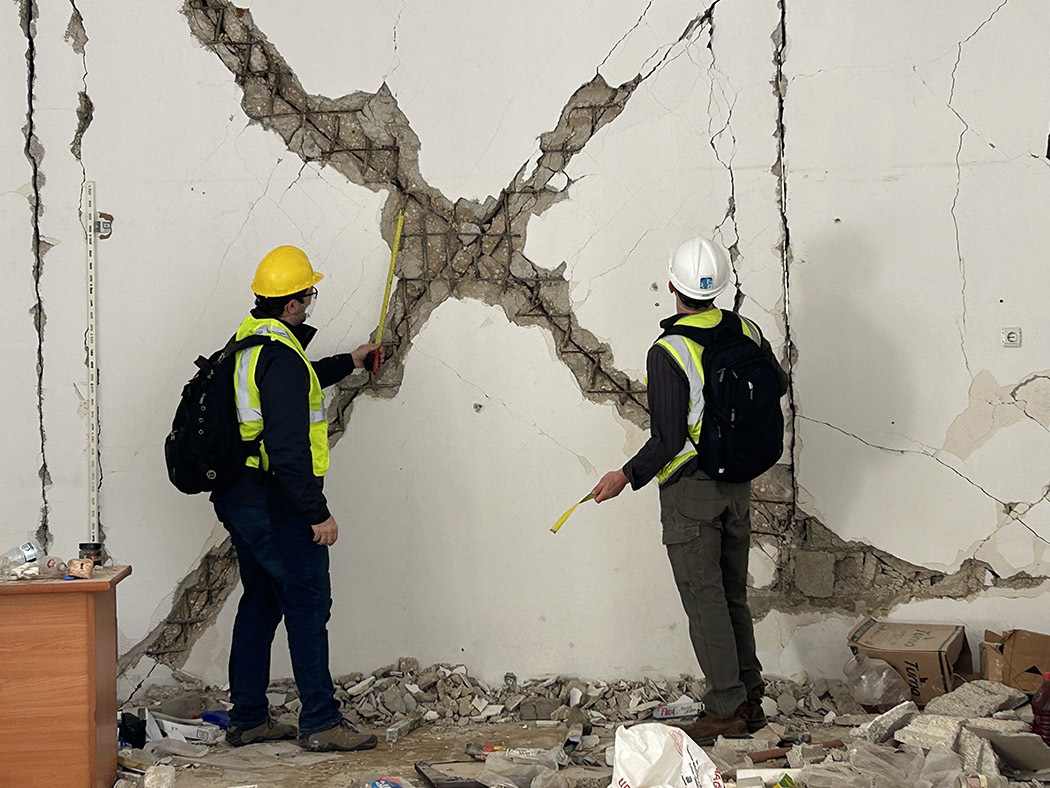Taking Measure
Just a Standard Blog
The Highs and Lows of Studying the Aftermath of One of Turkey’s Deadliest Earthquakes

We stood at the end of an alleyway filled with large blocks of rubble. I snapped a photograph, then slid my camera back into my pocket and continued down the seemingly vacant street.
A man perched introspectively on a motorbike across the way peered in our direction with glazed eyes.
We walked by and exchanged somber greetings. He told us the alleyway was the place where his brother had died, over a month earlier, when the ground shook.
This was his first time returning to the site to pay his respects.
The photo I took a few moments before weighed heavily in my pocket. There were no words to adequately express my condolences.
This was a low.
This was day two.

Weeks earlier, on Feb. 6, 2023, a sequence of deadly earthquakes struck south-central Turkey. More than 50,000 people died, and 100,000 buildings were damaged.
As NIST earthquake engineering researchers, Amin Hariri and I joined a team from the American Concrete Institute (ACI) to document the aftermath and collect data. It’s a different part of the world, a long flight, and a new culture. But it was an opportunity to learn something new and see how the information gathered may help better prepare for future earthquakes.
Soon after we arrived, the extent of the damage became evident. Even though we had seen the news reports, it was hard to comprehend the scale of the disaster. It felt a bit like a scene from an apocalyptic movie.
It was almost two months after the earthquake, and it seemed the recovery had only just begun. Damaged buildings filled street after street in town after town.
Some buildings stood as hollow shells of their former selves. Other buildings lay in piles of rubble. Empty lots where buildings once stood butted up against buildings that were waiting to be demolished. Many buildings had already been torn down and hauled away to ever-expanding landfills that were scattered throughout the countryside.
Workers were putting up tents and containers for temporary shelter on seemingly every piece of open land.
Seeing Disasters Up Close
As part of a team of researchers at NIST who deploy to collect data after disasters, I was a bit too familiar with the feeling of a heavy heart.
A few years earlier, I was in South Florida tagging broken building components after they were lifted off the pile created by the sudden and tragic partial collapse of the Champlain Towers South condominium. About 10 years before that, I was walking through the streets of Christchurch, New Zealand, after a major earthquake that would effectively shut down the central business district for years to come.
For an earthquake engineer and a researcher, the need to collect data and learn from disasters beckons.

Disaster after disaster, data is collected. Failures are studied. Reports are written.
But, as pointed out by professor, inventor and author Michael Bruneau in his 2022 book The Blessings of Disaster, “Countless reports ‘rest in peace’ on library shelves … [and] less fortunate others are ‘filed’ away in bankers boxes buried in archives.”
Our goal at NIST is to not only document and learn from disasters, but to also spur innovation and make recommendations that impact construction practices and help lessen the impact of the next disaster. And we have a record of doing just that.
One such example is the work done investigating the collapse of World Trade Center 7. As a result of this work, NIST helped create a standard that provides guidance to keep small failures in a structure from bringing down large portions of the building. This is known as disproportionate collapse.
Another example is our investigation into the impacts of the 2011 tornado that struck Joplin, Missouri, which led to improvements in building codes and emergency communications.
At NIST, there is a conscientious goal to bridge the gap between research and practice — a report should not die on a shelf.
Our Mission in Turkey
The main focus of the ACI team was to collect building data to test an assessment methodology known as the Hassan Index.
This methodology was developed in the 1990s by Mete A. Sözen, a world-renowned Turkish-born earthquake engineering professor, and his Ph.D. student, Ahmed Hassan. Their goal was to “help identify buildings with a high probability of severe damage.” In other words, this methodology attempts to identify the worst of the worst. It also offers the potential to set boundaries on typical building designs in terms of minimum amount of seismic force-resisting structural walls, known as shear walls, and glean other general observations.
The ACI team had more than 40 members, including a cadre of Turkish college students. The Turkish students helped us get access to buildings, served as translators, and collected important data.
The team collected Hassan Index data from more than 240 buildings, ranging from two-story schoolhouses to 16-story residential buildings. The data collected consisted of the amount of building damage and the building’s structural properties. Generally, the more walls and columns a building had, the better it fared.
Gathering Data on Post-Earthquake Functionality
Each disaster is different, but they all offer lessons and reminders.
A few months after the 2011 Christchurch, New Zealand, earthquake, I joined an American Society of Civil Engineering (ASCE) team to survey the damage. Christchurch’s downtown was closed off due to extensive damage. Even a few years later, large portions remained cordoned. Among numerous takeaways from that disaster was the importance of returning buildings to their normal function as soon as possible, known as functional recovery.
What good is a residential building if people cannot live in it? How do business centers survive and prosper if office buildings and restaurants are closed? Discussions involving resilience and functional recovery began to permeate many areas of research, practice and public policy.
The Christchurch earthquake was a reminder that the standards used to design buildings in the U.S. generally do not target functionality goals. Buildings in the U.S. are typically designed to have a small risk of collapse given a very large earthquake that happens once every few thousand years. Critical buildings, such as hospitals and emergency centers, are designed for some degree of post-earthquake functionality. Accounting for returning to functionality in noncritical buildings would better support resilience after earthquakes.
The loss of life was the most tragic aspect of the Turkey earthquakes, but the recovery of buildings, neighborhoods, towns and cities is also an issue to consider. People need to piece their lives and livelihoods back together.
For this reason, Amin and I also focused on collecting data related to functional recovery of buildings.

Before we left for the trip, we collaborated with our NIST colleagues Jarrod Loerzel and Siamak Sattar to develop a survey tool on our phones. This app enabled us to take photos, record audio notes, make sketches and take other notes regarding the seismic performance and recovery of a building. We collected this type of data for critical buildings, such as schools and hospitals, as well as buildings generally considered non-critical (commercial and residential). The goal was to test this new tool and gather preliminary data that may lead to recommendations for expanded studies on post-earthquake functionality.
It did not take us long to figure out that collecting functional recovery data is challenging and a bit nuanced. It often requires visiting a site over the course of weeks, months or even years and interviewing people who have knowledge of the recovery details.
In other words, you can’t just take a photo and walk around and inspect damage yourself to glean the information needed. It takes time and money to visit a site multiple times, and this earthquake reconnaissance trip was just one data point on the timeline.
We had varying success finding the right people to talk to. Not everyone who talked to us could confidently answer questions such as, “When will your business reopen?” Add in the fact that our conversations were being translated, and it was like a game of telephone.
An important takeaway was that to effectively collect building functional recovery data, local partnerships are key. For example, if a local researcher could visit a site over and over again for a period of years, they could learn valuable information we couldn’t get in one visit. This information could help do a better job of creating buildings that recover more quickly following the next big earthquake.
The Pursuit of Better Building Codes and Practice
In the wake of such tragedy, it seems nearly certain Turkey will have to update its policies, building codes, and design and construction practices to try to prevent such loss of life in future earthquakes. Our main focus is to improve U.S. building codes and practice, but we hope to make an impact on the international community as well.
We found instances where buildings that had no visible structural damage were slated to be demolished. How can this be? One rational reason is that Turkish buildings are typically built with unreinforced masonry infill walls. These walls are used to divide rooms and are not considered load bearing in the building’s overall structural design. For the most part, these walls did not fare well during the earthquake. Seeing damaged infill walls may have given people the impression that a building has structural damage, when in fact, this was not true.
So, while this damage was technically considered nonstructural, the result seems to be to tear it down and start over. It’s an understandable but sad outcome, given the environmental implications of buildings going into landfills and the societal implications of people losing their homes.
This gets back to some of the sentiments of the Hassan Index. This simple index promotes the idea that more walls (and columns to lesser degree) lead to better building performance. A corollary is that reduced drift (a measure of building movement) results in better performance. It’s not surprising that the less a building moves during an earthquake, the less damage it receives.
Other building materials could be the answer. Light-frame construction (cold-formed steel or wood) is used widely in the U.S. to create partition walls and facades. These types of partitions weigh substantially less than masonry infill and present less of a falling hazard.
Whether different materials are used in the rebuilding process in Turkey is yet to be seen. These concepts of using the Hassan Index to quickly identify vulnerable buildings, reducing drifts via more walls and columns, and using building materials that better accommodate drift could help save lives. They could also reduce the likelihood of a building prematurely ending up in a landfill.
Reminder of the Impact of Our Work
While we spent many long days collecting data on damaged buildings, we also experienced the culture and food of Turkey during our downtime.
Despite all they went through, the people of Turkey were extremely welcoming and hospitable to us throughout our stay.
In the evenings, after long days in the field, we enjoyed amazing kebabs and baklava. Our Turkish colleagues continually expressed thanks to us and the entire international team for joining the trip and trying to make a positive impact on the recovery and the future of earthquake engineering. This was a high.
Essentially every person in every city we visited was touched by the earthquake in some way — whether they’d lost a store that had been in their family for generations or, more tragically, a friend or family member.
Reconnaissance trips such as this are filled with highs and lows. The importance of an earthquake engineer’s work was in full view.
Earthquakes strike with little to no warning. This is a unique and deadly feature. Each earthquake is another opportunity to learn and improve. We saw firsthand how people are counting on the engineering community to design buildings that perform better during the next big one.
Earthquake reconnaissance missions give us more data and strengthen our resolve to improve policies, building codes and standards, with the goal of lessening the future impact of catastrophic events.
As the subtitle of the previously mentioned book highlights, there are lessons to be learned from each disaster, and lives and livelihoods depend on it.





